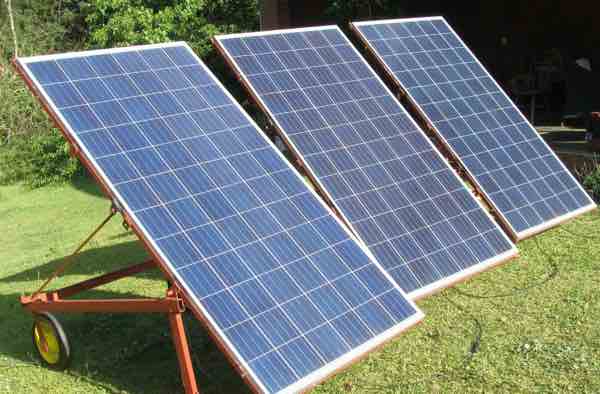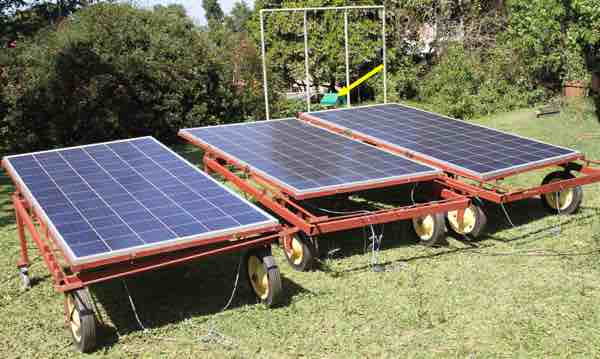- Bernard Preston homepage
- Solar geek
- Mobile Solar Panels
Mobile solar panels
Mobile solar panels are far more efficient since they follow the sun but require either a sophisticated tracking-device or need to be turned manually.
Since I am no electronics expert this page is only to do with mobile PVs
that can be manually moved to retain maximum-exposure to sunshine. It's a fun project, rather than something serious.
This page was updated on 2nd November, 2021.

Photovoltaic panels capture solar energy turning it into direct current usually maximally at around 45V. Losses in the cables are fairly high at this voltage, so we like to put three in series.
I could and perhaps should add a fourth-trailer as the voltage at the MPPT currently would still be less than 150V; my cables are too thin and the losses high.
Controllers generally will not cope with more than about 150V.
One could put all three panels on one mobile-trailer which can be easily turned to track the sun, or three separate smaller ones. Both have their merits, depending on circumstances.
Turning just one trailer obviously would be simpler, but the construction needs to be a lot heavier.
Mobile solar panels
Mobile solar panels produce up to 60 percent more energy. By changing the angle of the panel one can retain maximum exposure to radiation both in summer and winter, and early morning or afternoon, or at midday.
I have used the deckchair-principle enabling me to make the panels steeper for early and late in the day, but able to lay them flat around noon in summer when the sun is directly overhead; in summer that is.
Having a number of stops, one can select the correct orientation according to the position of the sun.
- Bernard Preston homepage
- Solar geek
- Mobile Solar Panels
The area around my home has trees and various walls so three individual mobile carts is more practical. Turning them is not arduous, but care has to be taken not to unplug the cabling.
It takes just a few minutes, three-times a day; one could do it every hour if you had the energy, or if suddenly in need of extra electricity when the good wife wants to turn the oven on.
Turning the panels
In the early morning and late afternoon, when the sun is just above the horizon, assuming there is minimal shading from trees and other buildings, the mobile solar panels need to be almost vertical.
In this situation they are vulnerable to strong winds, so a protective chain is necessary. It is always advisable to drop the panels during inclement weather to prevent damage.
On the other hand, during a hailstorm you would want them as steeply oriented as possible.
Then as the sun rises high in the sky, and moves to the north or south, the angle of the panels must be lessened, and the trailer turned to maintain maximum radiation.
A sophisticated solar tracker would do this continuously every moment; in practice I move mine about three or four times a day, depending on the need for electricity.
For example, if you know the dishwasher is about to come on, then you would want to make sure they are directly facing the sun.
Wheels
For my mobile solar panels, I chose two types of wheels, one of fixed orientation and the other able to turn; a brake on one or other would be advisable in case of strong winds; in practice, being retired and at home most of the time, it is almost never used however.
Fortuitously, not in the planning, the large fixed wheels ended up being lower than the smaller rotating wheels. Instead of turning the panels in the late afternoon through 90 degrees, simply dropping them means they retain most of the sunshine, and are still surprisingly effective. It means I do not have to do a major turn the next morning, which is bothersome.

Notice the green cover, arrowed, over the pump that supplies our home with rainwater from the reservoir. These three panels will amply supply the electrical demand.
Experimental mobile solar panels
These experimental mobiles were really just an exercise for fun. They are not a substitute for fixed panels on some roof or ground level structure.
Newsletter
Our newsletter is entitled "create a cyan zone" at your home, preserving both yourself and Mother Earth for future generations; and the family too, of course. We promise not to spam you with daily emails promoting various products. You may get an occasional nudge to buy one of my books.
Here are the back issues.
- Lifestyle and ideal body weight
- What are ultra-processed foods?
- Investing in long-term health
- Diseases from plastic exposure
- Intensive lifestyle management for obesity has limited value
- A world largely devoid of Parkinson's Disease
- The impact of friendly bacteria in the tum on the prevention of cancer
- There's a hole in the bucket
- Everyone is talking about weight loss drugs
- Pull the sweet tooth
- If you suffer from heartburn plant a susu
- Refined maize meal and stunting
- Should agriculture and industry get priority for water and electricity?
- Nature is calling
- Mill your own flour
- Bake your own sourdough bread
- Microplastics from our water
- Alternative types of water storage
- Wear your clothes out
- Comfort foods
- Create a bee-friendly environment
- Go to bed slightly hungry
- Keep bees
- Blue zone folk are religious
- Reduce plastic waste
- Family is important
- What can go in compost?
- Grow broad beans for longevity
- Harvest and store sunshine
- Blue zone exercise
- Harvest and store your rainwater
- Create a cyan zone at your home
Nevertheless, they have provided a useful boost to our solar power energy, especially in the early morning and late afternoon when they will exceed the output of those on the roof that face directly north; this is especially important after the equinox when the sun moves south of due east and west.
Should there be interest, you could contact me, I could put together a pdf on how to construct your own trailers. Knowing how to weld would be essential; it is neither dangerous nor difficult and certainly a skill worth learning for the person who enjoys backyard jobs.
I confess that building these trailers took a lot of thinking and planning, and time but only a small expense; but then I have little interest in watching television, so I have more hours to enjoy pottering in the workshop or garden.
I did consider putting them up on a pole, far easier to turn, but extreme weather conditions put me off; they could be dangerous if they came loose in high winds.
This is a commercial solar sentry trailer that is more mobile; and a lot more expensive.
Off the grid
We are again reassessing our decision not to go off the grid;
a recent surge of dirty power from the utility, coupled with another
massive price increase in 2020 makes it all the more attractive.
A change to lithium batteries has improved matters dramatically. The mains switch to the utility has been turned off for the last six weeks. Dare we cancel the contract?
Our mobile solar panels are still in daily use, contributing about 600W for much of the day.
Prepaid
Instead of going off the grid, we have decided to install a prepaid meter; that will avoid the monthly charge, regardless of how much power is used. The electricity is a rather more expensive, but we will continue to have hot water when needed in inclement weather. The main breaker remains off so that no further surges can damage our equipment.
Did you find this page interesting? How about forwarding it to a friendly book or food junkie? Better still, a social media tick would help.
- Bernard Preston homepage
- Solar geek
- Mobile Solar Panels
Address:
56 Groenekloof Rd,
Hilton, KZN
South Africa
Website:
https://www.bernard-preston.com